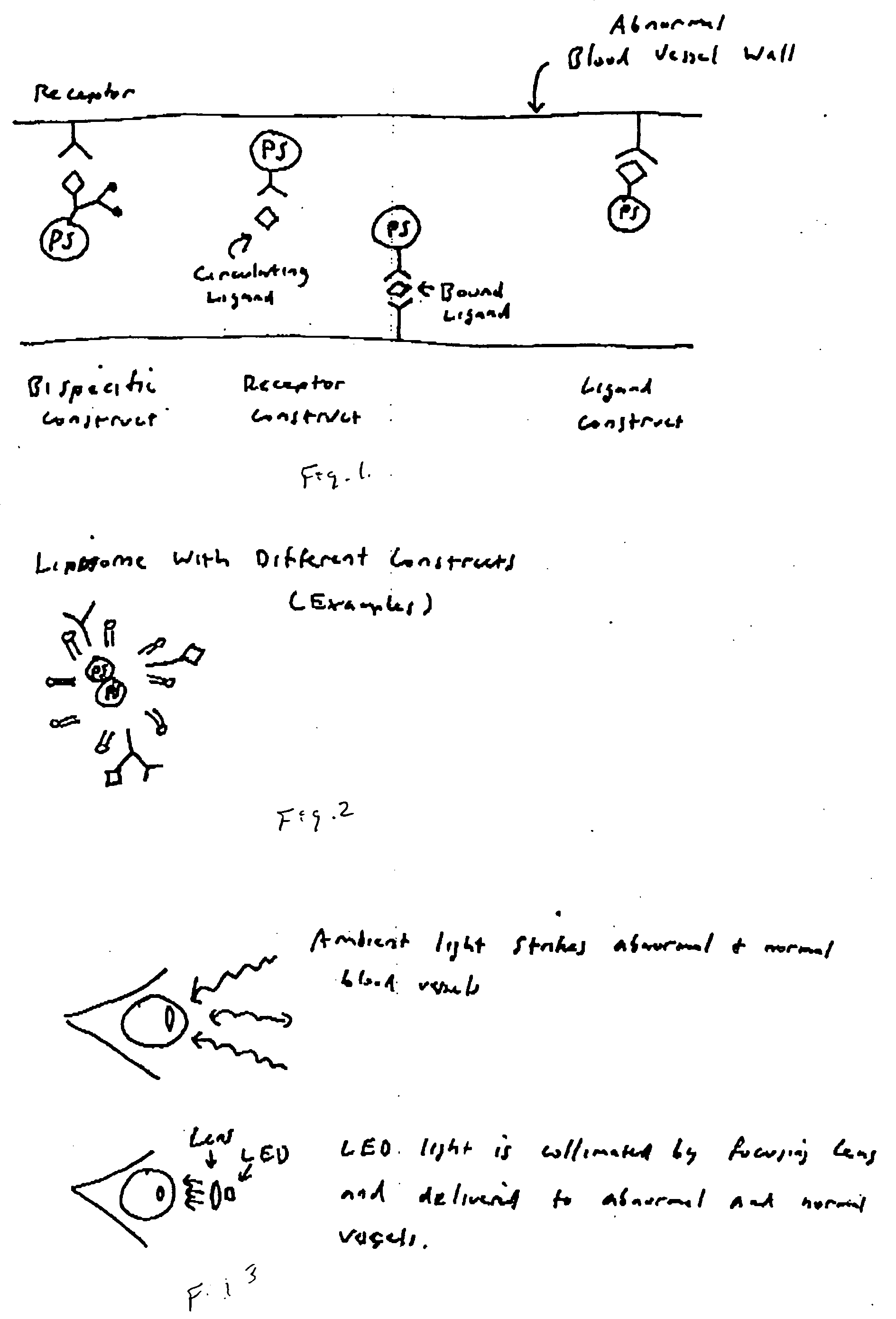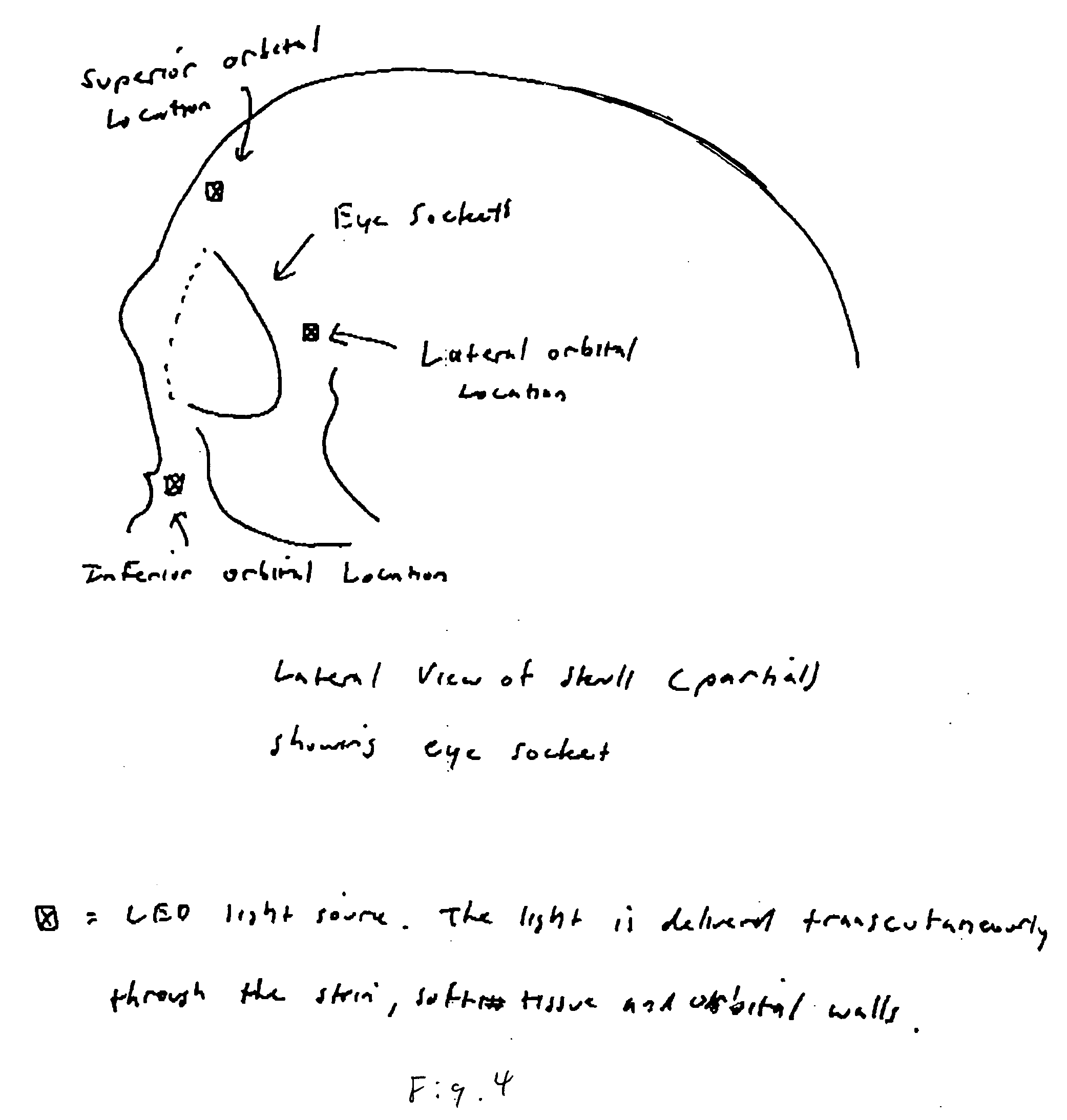Photodynamic therapy treatment for eye disease
a technology of photodynamic therapy and eye disease, applied in the field of medicine and pharmacotherapy, can solve the problems of harmlessness and further exposure to light of normal eye structures, and achieve the effects of reducing the amount of sensitizing drugs, reducing fluence rate or light irradiation, and maximal dosag
- Summary
- Abstract
- Description
- Claims
- Application Information
AI Technical Summary
Benefits of technology
Problems solved by technology
Method used
Image
Examples
example 1
Treatment of Choroidal Neovasculature Lesions
[0057] A subject with choroidal neovascularization (CNV) from age-related macular generation is assessed using standard visual acuity testing, ophthalmic examination, color photographs and fluorescein angiograms (see Miller et al., Ach. Ophthal. Vol 117:1161-1173 (1999)).
[0058] A photosensitizing agent, verteporfin, is conjugated using generally recognized methods in the art to a bindable fragment of the L19 antibody demonstrating high affinity to the ED-B of fibronectin (Birchler et al., Nature Biotech. 17:984 (1999)). A therapeutically effective amount of the photosensitizing agent conjugate, approximately 5 mg / m2, is administered intravenously to the subject.
[0059] Following a period of approximately 1 hour, to permit the non-specifically bound photosensitizing agent conjugate to clear from collateral tissues, the subject is irradiated in one or more sessions for a total period of 10 minutes with 400 mW / cm2 of collimated LED light h...
example 2
Treatment of Retinal Neovasculature Lesions
[0062] According to Example 1, a lipsomal benzoporphyrin derivative is conjugated to VEGF for use as a photosensitizer. The drug dose of 10 mg / m2 is administered to a subject with neovascular lesions in the retina of the eye via intravenous infusion over 10 minutes. The subject waits for a period of 6 hours to permit clearance from the tissues of non-specifically bound photosensitizing conjugate before illumination therapy is administered.
[0063] With the photosensitizer specifically localized to the retinal neovasculature lesions comprising VEGF receptor on the surface of the cells of the lesion, the subject is exposed to non-coherent light from a low power non-coherent broadband light source emitting at 690 nm. This illumination provides a radiant exposure of no more than 500 mW / cm2 for a period of approximately 20 minutes in one or more sessions producing a total fluence of illumination of about 600 Joules / cm2. Alternatively, coherent o...
example 3
Treatment of Vascular Tumors of the Eye
[0065] Integrin αvβ3 integrin is expressed by vascular cells during angiogenesis and vascular remodeling and is highly expressed by endothelial cells undergoing angiogenesis in tumors. See Eliceiri, B. P. et al., J. Clin. Invest (1999) 103(9):1227-1230. Antibody elicited to αvβ3, such as LM609 (Vitaxin; Eliceiri et al.) is conjugated to a texaphyrin photosensitizing agent in a liposomal formulation. A drug dose of 25 mg / m2 is administered via intravenous infusion over 10 min. The photosensitizer localizes to the neovasculature lesions. The pupils are dilated to allow ambient light enter for photosensitization. Therefore, no slit lamp is needed for photosensitization and the subject may continue every day activities while receiving PDT. The ambient light is used to photoactivate the photosensitizing agent for a total exposure time of 24 hours.
[0066] Screening examinations and visual acuity as disclosed in Example 1 is performed.
PUM
| Property | Measurement | Unit |
|---|---|---|
| time | aaaaa | aaaaa |
| time | aaaaa | aaaaa |
| time | aaaaa | aaaaa |
Abstract
Description
Claims
Application Information
 Login to View More
Login to View More - R&D
- Intellectual Property
- Life Sciences
- Materials
- Tech Scout
- Unparalleled Data Quality
- Higher Quality Content
- 60% Fewer Hallucinations
Browse by: Latest US Patents, China's latest patents, Technical Efficacy Thesaurus, Application Domain, Technology Topic, Popular Technical Reports.
© 2025 PatSnap. All rights reserved.Legal|Privacy policy|Modern Slavery Act Transparency Statement|Sitemap|About US| Contact US: help@patsnap.com


